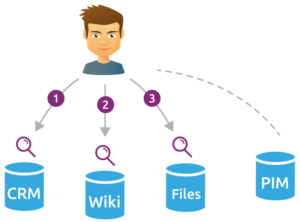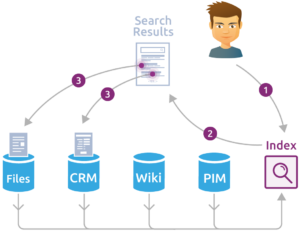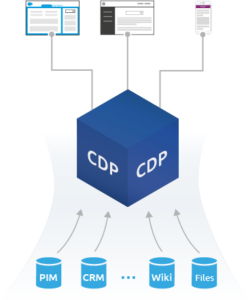What a Content Delivery Platform is – and is not
Antidot has a strong reputation for developing advanced information access technologies: semantic search, content classification, etc. – used in many high-profile projects. But as the market matures, after trials and pilot projects, enterprises better understand the use cases these technologies can solve and instead of “building blocks” that need to be assembled through lengthy projects, buyers are now looking for full-featured industrial solutions.
This is why we invested heavily in a new type of software to solve the challenge of efficient and agile knowledge spreading – think proactive information, chatbots, predictive customer support, etc. This software is called CDP, or Content Delivery Platform.
In this post, we are reviewing what makes a CDP different from previous approaches, and the benefits it brings.
The Content Delivery Platform
A Content Delivery Platform is a software solution that creates a repository of smart information and acts as a secure single point of delivery.
More specifically, a CDP:
- collects content from existing sources, structured records or unstructured documents;
- processes and transforms this content beyond its initial format to turn it into fine-grained, enriched and actionable information; and
- makes this augmented information accessible to applications and processes in a contextual and tailored way.
For more details of what a CDP is, see the Content Delivery Platform page.
But it is also important to understand what it is not.
CDP and multiple content sources
At the risk of stating the obvious – a CDP is not an authoring environment, nor does it replace or modify any of the existing applications that generate, store and manage content. However, as these applications are usually designed for a specific purpose (CRM, helpdesk tools, Web CMS, wikis, file servers, etc.), they are not suited for fueling other channels by adapting the content to the target end-point.
 In an IT landscape made of multiple applications, users looking for information about a product would have to connect to different sources, search each one separately, and move to the next one until they find what they want, and go through all of them to make sure they are not missing any critical piece.
In an IT landscape made of multiple applications, users looking for information about a product would have to connect to different sources, search each one separately, and move to the next one until they find what they want, and go through all of them to make sure they are not missing any critical piece.
This tedious process is not only inefficient but also error prone:
- Not knowing the existence of a source or not having proper access means invisible content and lost information.
- Search is inconsistent across the different sources and requires knowing each tool and adapting the search strategy.
- It is costly (in terms of licenses) as it requires that every user has access to each application, at least as a reader, hence complexifying the security setup.
- The results are in formats that are intrinsically bound to the source applications, and not tailored to other needs and situations.
For example, looking for spare part references would require having access to the PIM (Product Information Management) application, knowing how to search and navigate the PIM, and the resulting info may not be easy to understand or to reuse for customer support purpose.
CDP and search engines
A CDP is not a federated search engine either, and it even transcends this legacy approach.
 To a degree, the addition of enterprise search simplifies information discovery:
To a degree, the addition of enterprise search simplifies information discovery:
- The user has a single place to go to for searching;
- The fear of missing a piece of content is gone;
- The search is federated and becomes consistent.
But this approach still has many drawbacks that hamper efficiency. As the search engine returns links pointing to content, the user still has to connect to the source and to open the document to read it:
- The user still needs access to each application (incurring license costs and security complexity);
- They must know the app (training costs);
- They are still bound to the format of the document to be able to exploit the information it contains.
Feeding multiple processes and apps
Feeding several processes and apps with content coming from multiple sources adds another dimension to the complexity of content delivery.
 A Content Delivery Platform does solve all of the challenges listed above:
A Content Delivery Platform does solve all of the challenges listed above:
- It creates a single access point, one place to unify all information needed to solve specific business challenges across the enterprise.
- It brings consistency to formats of content and to metadata.
- It applies security rules that are suited to varied delivery situations and to the profile of the users, controlled in a central manner.
- It allows dissemination through multiple channels.
A Content Delivery Platform is not just static content, pre-generated and dumped somewhere on a web server or in a database with a search engine glued on top. It also provides business logics, the ability to serve information contextually, dynamically tailored to the user, to the channel and to the moment
For more insights on the core capabilities of a Content Delivery Platform, continue reading here: Content Delivery Platform page.

